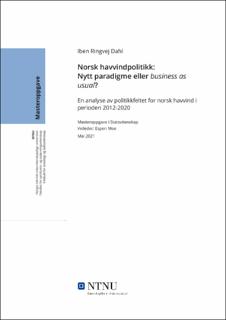| dc.description.abstract | Denne oppgaven har analysert politikkfeltet for norsk havvind i perioden 2012-2020. Bakgrunnen var en økt politisk interesse for havvind høsten 2019, da statsforetaket Enova bevilget 2,3 milliarder til oljeselskapet Equinor for å bygge verdens største flytende havvindpark. Deretter vedtok Regjeringen sommeren 2020 å åpne to havområder samt en Havenergilovforskrift, for fornybar havenergiproduksjon, hvilket betød at en grunnleggende forutestning for å bygge et hjemmemarked, kom på plass. Formålet har vært å (1) forklare de observerte politikkendringene og (2) besvare problemstillingen om disse representerer noen substansiell endring i klima- og energipolitikken.
Til det første ble benyttet statsvitenskapelig og sosioteknisk forankret litteratur om bærekraftsomstilling, og Kingdons flerstrømstilnærming (MSA). Det ble tatt utgangspunkt i Normanns (2015, 2017) konklusjoner om at det såkalte mulighetsvinduet for et norsk hjemmemarked for havvind i 2012 ble lukket, hvorfra premisset ble utledet om at dette mulighetsvinduet etter dette er blitt åpnet.
Analysen sannsynliggjør at politikkendringer som forventet har vært betinget i endringsimpulser skapt av eksterne sjokk, hovedsakelig oljeprisfallene i perioden, samt enkeltpersoners politiske agency for å utnytte disse impulsene. Industrien og Stortinget framstår i stor grad som pådrivere for endringene. Et annet hovedfunn er at forskjellen mellom de politiske ambisjonene for ulike havvindteknologier, viser at lovnadene disse energiteknologiene gir for eksisterende industri er en viktigere forklaringsfaktor enn modenhet. Dette viser igjen at industripolitiske motiver er viktigere enn de klimapolitiske, i norsk havvindpolitikk.
Energipolitikkens prinsipp om at utbygging av ny kraftproduksjon skal være samfunnsøkonomisk lønnsom på kort sikt ble identifisert som en foreløpig hindring for en havvindpolitikk rettet mot klimapolitiske mål. En nedrangering av dette prinsippet ble derfor operasjonalisert som kriterium for det paradigmeskifte jeg ville påvise. Denne forventningen ble det ikke funnet støtte for. Derimot utgjør særlig utviklingen av Enova og dets bevilgning et forsøk på å tilpasse paradigmet på en måte som kan gjøre at et paradigmeskifte er sannsynlig i fremtiden.
Nøkkelord: Havvind, fornybar energi, energiomstilling, policy-paradigmer, policy-entreprenører, særinteresser, regimer, nisjer | |
| dc.description.abstract | This thesis has investigated the policy area for offshore wind in Norway between 2012-2020. The topic was chosen based on an observed increased political interest in offshore wind (OSW) in 2019, when the state-owned enterprise Enova granted the Norwegian petroleum company Equinor 2.3 billion NOK to build the world's biggest floating OSW farm in the North Sea. Second, the Norwegian government in June 2020 decided to open two sea basins for offshore renewable energy production and adopted a regulation that establishes procedures for project owners applying for license to operate, effectively installing important prerequisites for building a domestic market for OSW. The objective has been to (1) explain why the policy changes occurred, and (2) respond to the research question of whether these policies represent substantial changes in Norwegian climate and energy policies.
As to the first, the investigation was carried out using theories of sustainable energy transitions, notably Aklin & Urpelainens (2018) approach anchored in political science, and concepts from the socio-technical branches of the same overarching body of literature. This was combined with Kingdon's (2014) Multiple Streams Approach (MSA), to highlight the role of agency in political decision-making and agenda setting. Building on Normann's (2015, 2017) conclusion that a window of opportunity for a domestic OSW market was closed in 2012, it was assumed that this window has since then been opened again. Secondly, Hall's (1993) conception of policy paradigms was used to classify the observed policy changes.
The analysis supports the expectation that policy changes were contingent on impulses created by exogenous shocks, essentially the oil price plunges in the period, and the political agency of individuals (policy entrepreneurs), to exploit these temporary impulses, i.e. windows of opportunity. Beside individual policy-entrepreneurs and coalitions in Parliament, important advocates for OSW policies were found within segments of the industry. Relatedly, a key finding is that the opportunities that different OSW technologies, i.e. floating and bottom-fixed, represent for incumbent industries is a stronger explanatory factor than their maturity. This, in turn, documents the more general conclusion that industry motives are a more potent driving force behind Norwegian public OSW politics, than climate-political ones.
Energy-political objectives, on the other hand, has previously restricted implementation of OSW and other immature energy technologies, as new energy production is contingent on a criterion of short-term cost-efficiency. A degradation of this principle, therefore, was operationalized as a criterion for the paradigmatic change I seeked to detect, i.e. towards utilizing Norwegian OSW resources for a rationale of mitigating climate change. This expectation was not confirmed by empirical evidence. However, Enova's grant and the preceding changes to the enterprise's mandate that enabled it, constitute a political effort to alter the paradigm towards societal pressures in a manner that threatens that paradigm's survival. This makes probable a paradigm shift in the future.
Keywords: Offshore wind, renewable energy technologies, energy transition, policy paradigms, policy entrepreneurs, vested interests, regimes, niches | |
